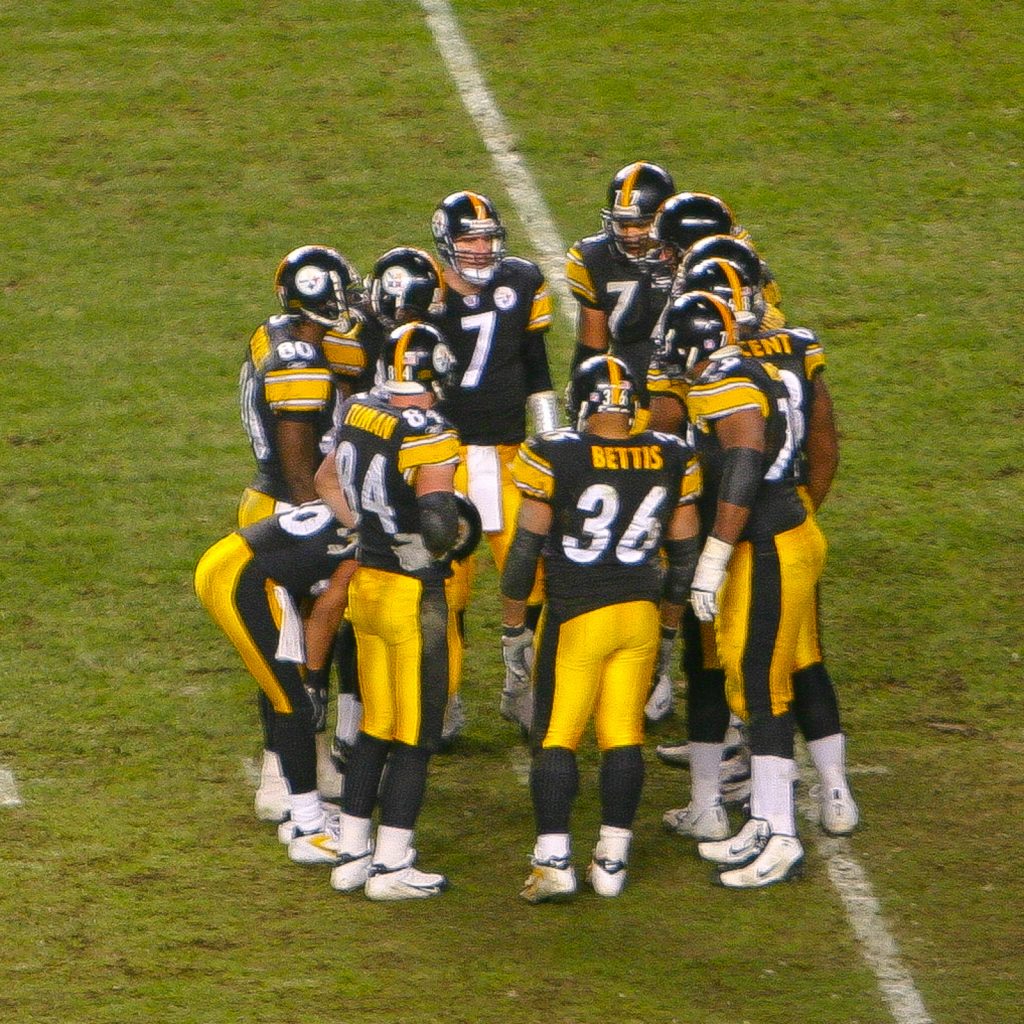The Origins of the Football Huddle

Over the weekend, American football fans were treated to an exceptional set of games, all of which came down to the final minutes. If you watched the games, you’ll remember the big passes and key kicks which established the back-and-forth scoring throughout the two days of football. But you also saw a lot of players standing around doing apparently nothing, as seen above (from a game that wasn’t played last weekend).
The activity pictured above is something called a “huddle.” A bunch of football players gathers in the middle of the field. They’re not discussing random topics like jammed eyelids, hexed sports equipment, or what makes for an appropriate wedding present — rather, they’re making sure everyone is coordinated for the next play. It’s a critical few seconds where the quarterback (he’s the guy wearing jersey #7 above) tells his teammates what they’re all supposed to do. If the play is a run, and the running back (that’s Bettis, #36) doesn’t know that the quarterback is going to hand him the ball, things are going to go badly. Similarly, the tight end (#84) needs to know if he’s supposed to be blocking for that running back or looking for a throw from the quarterback. If any of the ten non-QB players zones out, things will go badly.
For long-time football fans, the huddle is just part of the game — one we probably don’t give much thought to. But you don’t often see these team-wide meetings in other sports. There are lots of ways for coaches and other players to signal to their teammates without needing to gather in a circle like this. Even in football, the quarterback can change the play after the huddle by shouting out some codewords (this is called an “audible“). So why do football players huddle?
Originally, they weren’t gathering to talk — at least, not aloud.
American football has been around since 1869 or 1875, depending on who you ask. (That’s a story for another day, maybe.) It took about two decades, but the sport became a hallmark of intercollegiate competition before the century came to a close. Plays were much less complicated than today’s plays (the forward pass wasn’t legal in college football until 1906, for example), but players still needed to know who was going to run the ball and in which direction. That’s not terribly hard to do; you just whisper the basic instruction to one another right before snapping the ball. It’s not hard to imagine a bunch of players saying something like “Wilson, wide right” to each other before each play.
But for Gallaudet University, sharing the play that way wasn’t an option. Gallaudet, founded in 1864, is a leading university for the deaf and signing community, as it has been since its inception. Its football team, like the rest of its student body, used American Sign Language to communicate with one another. In most football games, this wasn’t a problem and could even be an advantage — the coach or QB could sign the play to the other players, and the opposing team had little to no chance of figuring out the “code.” But in 1894, Gallaudet’s football schedule had two opponents that knew ASL well — the Pennsylvania Deaf School and the New York Deaf School. In those games, signing the plays would be, effectively, telling your opponent what was coming next.
That year, the Gallaudet quarterback, Paul Hubbard, decided to gather his team together before each play. The tight-knit circle — the huddle — created a shield of bodies, allowing him to sign the next play to everyone else without the opponents being able to read along. Most likely it worked — while Gallaudet as a mediocre team in its other six games (three wins, two losses, and a tie), it notched victories against both of its signing opponents — they beat the Pennsylvania team 24-0 and the New York school 20-6.
The tactic was quickly adopted by other, hearing teams, and has become a mainstay of the sport ever since.
Bonus fact: If you’re an American who grew up speaking English, you’re probably able to understand an English-speaking British person, even though accents and dialects are different. You probably cannot understand a French speaker, though — French and English are different languages, after all. But the same may not be true if you know American Sign Language. ASL is derived from a 1900s version of French Sign Language and as much as 60% of ASL uses terms and phrases from that language. On the other hand, ASL and British Sign Language are “mutually unintelligible.”
From the Archives: How Blind People Play Baseball: No huddles, but lots of beeps.
